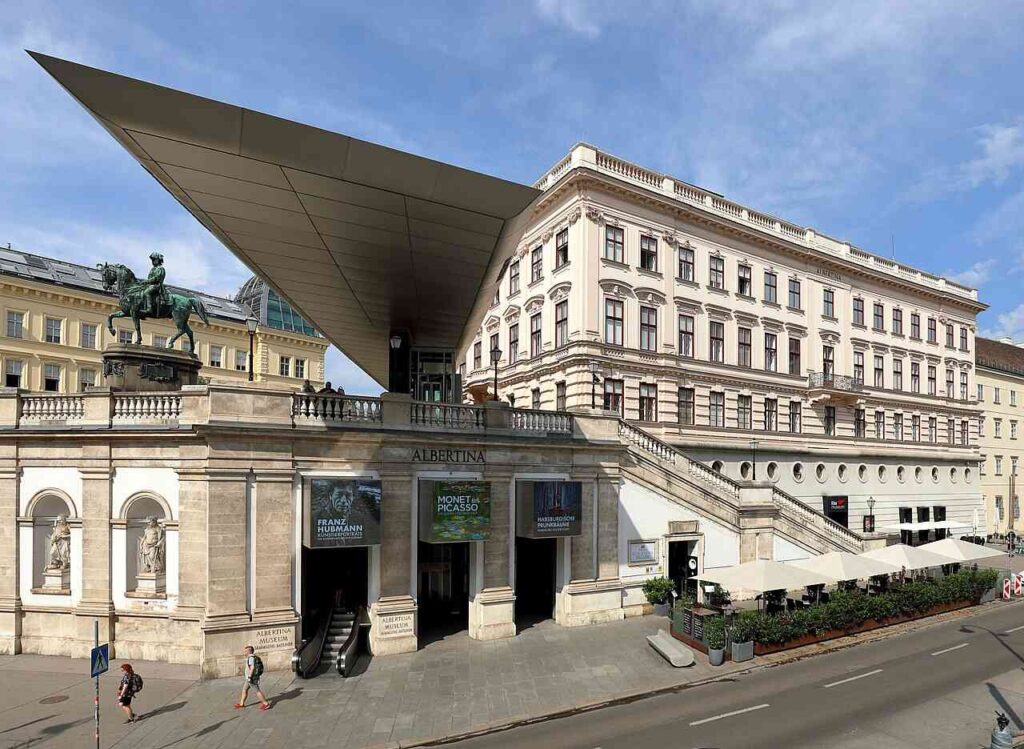Perched majestically atop the final bastion of Vienna’s old city walls, the Albertina Museum stands as both a former Habsburg palace and one of the world’s most important art museums. Its elegant neoclassical facade, crowned by a dramatic modern flying roof designed by architect Hans Hollein, signals the perfect blend of historical grandeur and contemporary vision that defines this extraordinary institution.
Within its walls lies an artistic treasure trove spanning 600 years—from Dürer’s “Young Hare” to Monet’s water lilies, from Michelangelo’s studies to Picasso’s blue-period masterpieces.

Albertina Museum – From Ducal Collection to World-Class Museum
The Albertina’s story begins in 1768 when Duke Albert of Saxe-Teschen, a passionate art collector and son-in-law of Empress Maria Theresa, established his collection in the elegant palace that now bears his name.
Albert and his wife Archduchess Marie Christine had a particular fondness for works on paper, laying the foundation for what would become the world’s largest and most important collection of graphic arts.
After Duke Albert’s death in 1822, the collection—and the palace itself—passed through generations of Habsburg archdukes. Each contributed to the growing treasury of artistic works, with Archduke Friedrich making particularly significant acquisitions before the collection was nationalized following the fall of the Habsburg monarchy in 1918.
The 20th century brought both challenges and triumphs to the Albertina. Heavily damaged during World War II bombing raids, the palace underwent meticulous restoration. The museum reopened to great acclaim in 2003 following an extensive renovation that dramatically expanded its exhibition spaces and modernized its facilities while carefully preserving the historical Habsburg state rooms.
Book a Ticket to the Albertina Museum >>
A Collection Beyond Compare
Today’s Albertina houses approximately 50,000 drawings and watercolors and over 900,000 prints, creating one of the world’s most comprehensive records of artistic achievement. The museum’s graphic collection includes masterworks by Leonardo da Vinci, Raphael, Michelangelo, Dürer, Rubens, Rembrandt, and countless others—many so delicate they can only be displayed in rotation to protect them from light damage.
Beyond its renowned works on paper, the Albertina has expanded its scope to include significant collections of paintings. The Batliner Collection, permanently housed at the museum since 2007, traces the development of modern art from Monet to Picasso and beyond, featuring outstanding works by French Impressionists, German Expressionists, and Russian avant-garde artists.
The museum has also established itself as a center for photography, housing over 100,000 photographs from the earliest days of the medium to cutting-edge contemporary works. Its architectural collection documents the evolution of building design from the Renaissance to the present day, offering insights into how architects have shaped our world.
The Habsburg State Rooms: Living History
A visit to the Albertina offers not just artistic treasures but a glimpse into imperial life through its spectacular Habsburg State Rooms. Restored to their late 18th-century splendor, these 21 rooms showcase the lavish lifestyle of their royal inhabitants. The Gold Cabinet, with its gilded neoclassical ornamentation, and the Hall of the Muses, adorned with magnificent crystal chandeliers, exemplify the refined taste of Duke Albert and Archduchess Marie Christine. For the complete experience you should visit the Imperial Treasury at the Hofburg Palace.
Walking through these opulent apartments, visitors experience firsthand the aesthetic and cultural environment that nurtured the Albertina’s founding collection. Period furniture, silk wall coverings, and intricate parquet floors create an authentic setting that brings Habsburg Vienna to life.
Book a Ticket to the Albertina Museum >>
The Modern Albertina: A Dynamic Cultural Hub
Under the leadership of its visionary directors, the Albertina has evolved from a scholarly print cabinet into one of Europe’s most dynamic cultural institutions. Its exhibition program balances presentations from the permanent collection with ambitious temporary shows highlighting everything from Renaissance masters to contemporary artists.
The museum’s expansion in recent years has created dramatic new spaces for displaying art. The modernist flying roof that now extends over the entrance plaza has become an architectural icon in its own right, while the underground Bastei exhibition halls provide vast, flexible galleries for major exhibitions.
Digital innovation has made the Albertina a leader in art education and accessibility. Interactive displays, multimedia guides, and online resources allow visitors to engage with the collection on multiple levels, while the museum’s research department continues to advance scholarship on its holdings.
Albertina Museum – A Visitor’s Paradise
Today’s visitors to the Albertina find a museum that embraces both tradition and innovation. The central location—just steps from the Vienna State Opera and the pedestrian Kärntner Strasse—makes it an easy addition to any Vienna itinerary. The museum café offers refreshment with views of the Burggarten, while the shop provides thoughtfully curated art books and gifts.
Special exhibitions change regularly, ensuring there’s always something new to discover. Evening openings and regular events—from curator talks to concerts in the state rooms—provide unique ways to experience the collection. Children enjoy dedicated programming and interactive spaces designed to inspire young art lovers.
Book a Ticket to the Albertina Museum >>
A Living Legacy
The Albertina represents not just Austria’s artistic heritage but a commitment to making that heritage accessible and relevant to contemporary audiences. As the museum continues to evolve, it remains true to Duke Albert’s founding vision of creating a place where art can be preserved, studied, and enjoyed by generations to come.
As the celebrated Austrian writer Stefan Zweig once wrote of Vienna’s cultural treasures: “The miracle of collected art creates a magical space outside time, where the creative spirits of every epoch meet and converse. In such places as the Albertina, we do not merely observe history—we experience the living breath of human imagination across the centuries.”